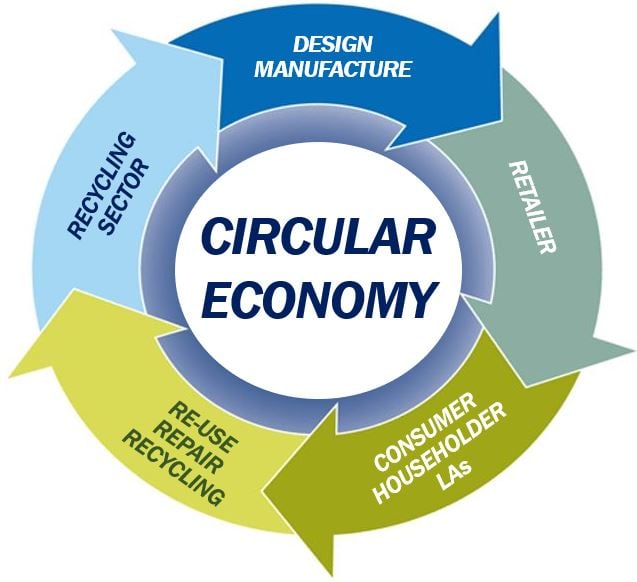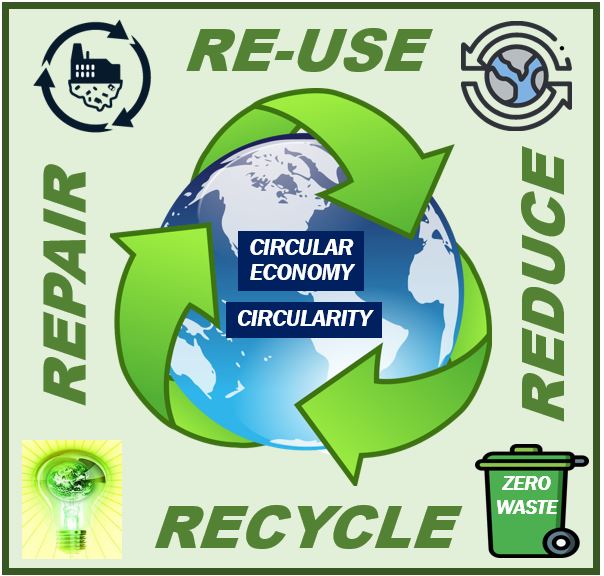In today’s traditional linear economy, products often follow a “take-make-dispose” path. We take raw materials from the Earth, make them into products, use those products, and then dispose of them as trash. In other words, many items are made to be used once or for a short time, and then thrown away. This one-way system creates a lot of waste and requires constant use of new resources. For example, think of a cheap plastic toy or a single-use water bottle – they’re used briefly and then end up in a landfill.
By contrast, a circular economy works more like a loop than a line. Instead of designing products for quick use and disposal, a circular economy designs products to be reused, repaired, or recycled so they last as long as possible. The goal is to minimize waste and keep materials in use again and again.
For example, a phone designed under circular principles would be easy to repair or upgrade, and when it truly can’t be used anymore, its components (like metals and plastics) would be recycled to make new devices rather than being thrown out. This approach is inspired by nature – in the natural world, one organism’s waste is another’s resource, and materials cycle endlessly (think of the “circle of life,” where dead matter becomes nutrients for new life).
A circular economy tries to mimic these natural cycles in our industrial world, ensuring that everything has value and nothing is wasted.
Embracing circularity, businesses not only contribute to environmental sustainability but also signal to increasingly eco-conscious consumers their commitment to responsible stewardship of resources.

Circular economy – use things for longer
Shifting from a linear to a circular economy matters because our current linear habits are unsustainable. Humans are using resources at a rate that Earth cannot replenish.
The linear “take-make-dispose” model leads to overflowing landfills, polluted oceans, and wasted energy. Right now, only a fraction of what we use is cycled back into the economy; most of it ends up as waste. This linear system is depleting natural resources (like forests, minerals, and water) and creating pollution at a scale the planet can’t handle long-term.
The aim of a circular economy is to use infrastructure items and equipment for significantly longer than usual, i.e., improving these resources’ productivity. Any type of waste should not be thrown out. Rather it should become another process’ food.
Our perspective must change
For the circular economy to ever exist properly, there needs to be a dramatic change in people’s and companies’ perspectives regarding value creation, employment, the scarcity of resources, and environmental impact.
Our planet is currently facing some serious problems caused by economic activity and household consumption. The World Bank says that the OECD nations generate 572 tons of garbage annually. This represents 44% of the world’s total. However, the OECD’s population makes up less than 20% of the world’s population.

Business leaders embracing the circular economy
The price of many natural resources as well as essential materials are skyrocketing. The world’s advanced economies have become aware of this and are currently closely examining alternative economic models – especially the circular economy.
It’s already being put into practice by businesses, industries, and governments around the world. Here are some examples of how circular principles are being applied in real life:
Electronics
Think about the smartphones and tablets we use – what happens when they break or become outdated? In a linear system, many old gadgets would just be thrown away, adding to electronic waste. But now companies are embracing circular thinking to change that. A great example is Apple’s recycling robot Daisy.
Daisy can take apart hundreds of iPhones every hour to recover valuable materials like cobalt (from batteries), aluminum, and tin. Instead of mining new metals from the ground, Apple can reuse materials from old iPhones to make new products.
Other electronics companies have similar programs where you can trade in old devices to be fixed up or recycled. Designing products for easy repair and disassembly is a key part of the circular economy. For example, some phones and laptops are now built with modular parts – if one part breaks, it can be replaced without throwing the whole device away. By repairing, refurbishing, and recycling electronics, we keep gadgets in use longer and reduce the need to constantly extract new raw materials.
Fashion and Textiles: Extending the Life of Clothes
The clothing industry is another area where circular economy ideas are taking hold. Many of us have experienced “fast fashion” – cheap clothes that wear out or go out of style quickly, leading people to toss them after only a few uses. This creates huge amounts of textile waste. In a circular economy, the goal is to extend the life of clothes and reuse materials.
For example, the outdoor clothing company Patagonia is known for encouraging customers to repair and reuse their products instead of throwing them away. Patagonia’s Worn Wear program provides tips and tools for fixing clothing (like sewing tears or patching jackets), and the company offers free repairs on their gear to help it last longer. They even have a marketplace for second-hand Patagonia clothing, so jackets and shirts can have a “second life” with new owners instead of ending up in the dump.
This is a real business example of circularity: Patagonia’s approach reduces waste and saves the resources that would be needed to make new clothes from scratch.
Other brands and organizations are following suit – from clothing take-back programs (where you can return old clothes to be recycled into new fabric) to thrift stores and second-hand marketplaces becoming more popular. Even a shopping mall in Sweden called ReTuna is fully dedicated to second-hand goods, reselling upcycled items from furniture to electronics.
All of these efforts keep clothing and textiles circulating in the economy, which means fewer new fabrics need to be produced (saving water, energy, and reducing pollution from factories) and less old clothing goes to landfill.
The circular economy is all about rethinking how we design, use, and dispose of things so that waste is minimized and resources are continually cycled back into use. Unlike the throwaway culture of the linear model, circularity encourages us to see value in old materials and to design products that can last.
